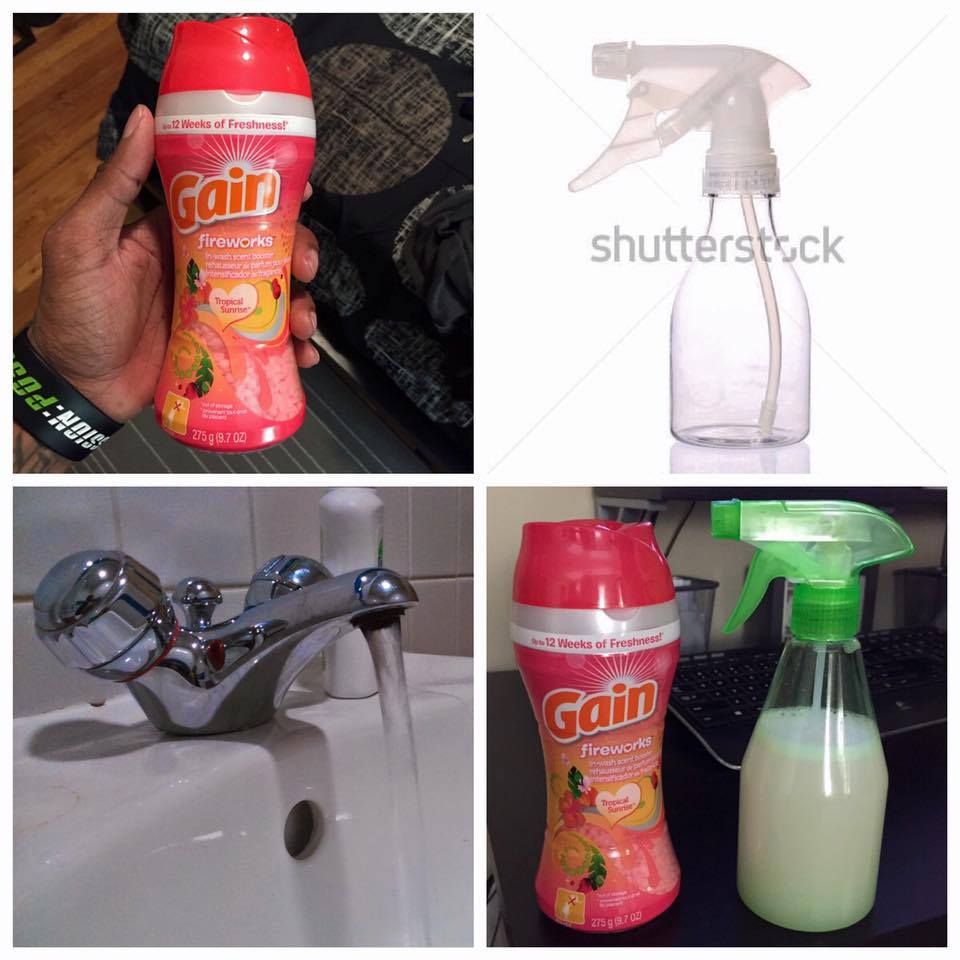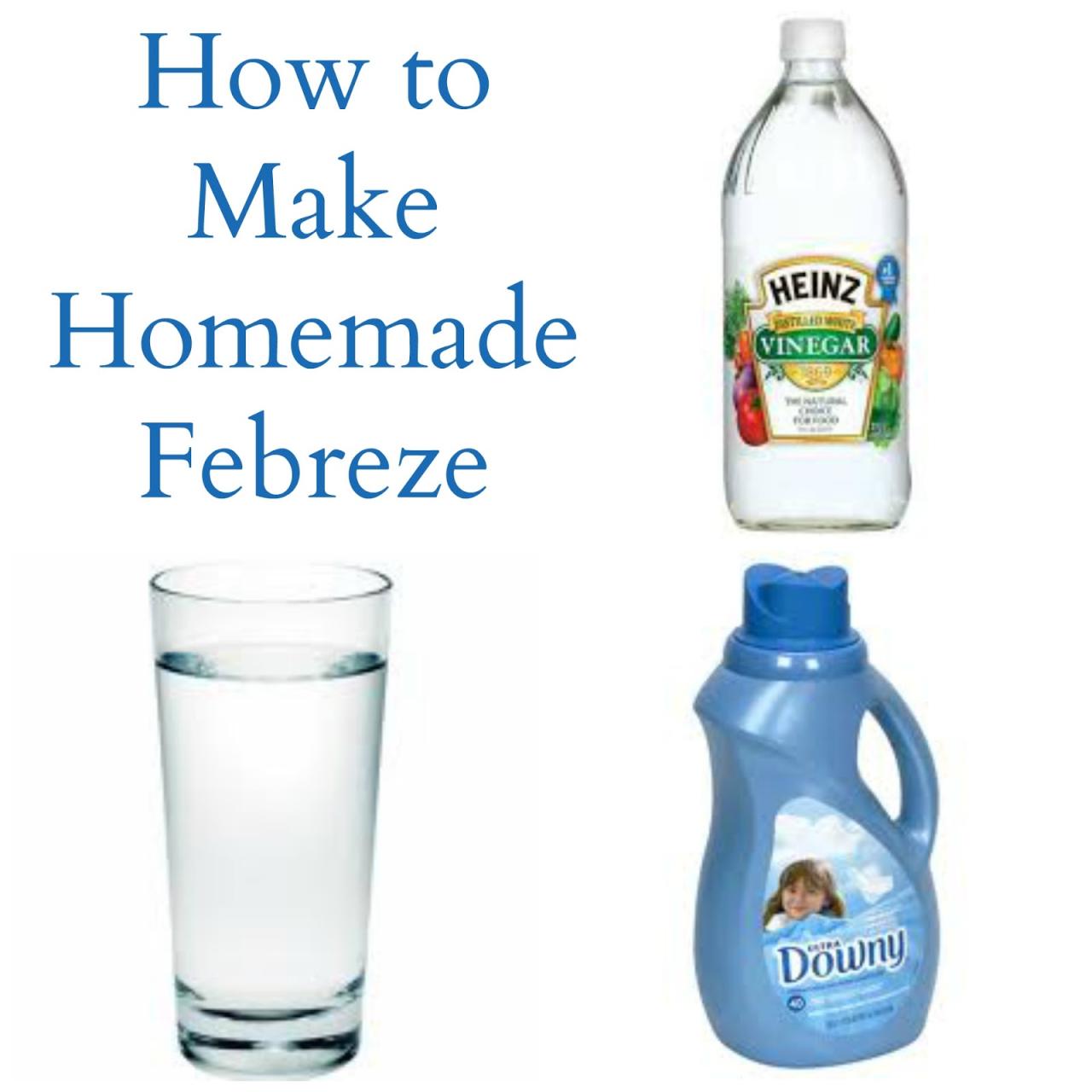Homemade Febreze offers a refreshing alternative to store-bought air fresheners, allowing you to create customized scents and control the ingredients. By combining essential oils, vinegar, and water, you can eliminate odors and infuse your home with delightful aromas.
This guide explores the process of making homemade Febreze, from selecting the right ingredients to crafting unique scent blends. We’ll delve into the benefits of using homemade Febreze, discuss safety considerations, and explore creative applications beyond traditional air freshening.
Homemade Febreze
Homemade Febreze is a DIY air freshener that utilizes readily available ingredients to eliminate odors and impart a pleasant scent. The appeal of homemade Febreze lies in its affordability, customization, and the ability to avoid harsh chemicals found in commercial products.
Motivations for Making Homemade Febreze
Creating homemade Febreze is driven by various factors, including cost-effectiveness, environmental concerns, and the desire for personalized scents.
- Cost-Effectiveness: Homemade Febreze offers significant savings compared to store-bought options. The ingredients are typically inexpensive and readily available, making it a budget-friendly alternative.
- Environmental Concerns: Many commercial air fresheners contain volatile organic compounds (VOCs) that can contribute to indoor air pollution. Homemade Febreze, using natural ingredients, minimizes the release of harmful chemicals into the environment.
- Personalized Scents: Homemade Febreze allows for customized scent profiles. Individuals can experiment with different essential oils and combinations to create unique and desirable fragrances for their homes.
Benefits of Homemade Febreze
Homemade Febreze offers several advantages over commercial air fresheners:
- Natural Ingredients: Homemade Febreze relies on natural ingredients like essential oils and baking soda, which are generally safer for human health and the environment than synthetic chemicals.
- Customizable Scents: The ability to personalize scents is a key advantage. You can tailor the fragrance to your preferences and create unique blends that suit your mood and environment.
- Cost-Effectiveness: Homemade Febreze is significantly more affordable than store-bought options. This makes it an attractive alternative for those looking to save money without compromising on quality.
- Reduced Chemical Exposure: Homemade Febreze minimizes exposure to harsh chemicals found in commercial air fresheners, which can be beneficial for individuals with sensitivities or allergies.
Essential Ingredients for Homemade Febreze
Homemade Febreze, a DIY alternative to commercial air fresheners, is a popular choice for those seeking a natural and cost-effective way to eliminate odors. The key to creating effective homemade Febreze lies in understanding the role of each ingredient and choosing the right combination to achieve the desired results.
Common Ingredients and Their Purposes
The most common ingredients used in homemade Febreze recipes fall into three main categories:
- Water: Water acts as a solvent, dissolving the other ingredients and creating a liquid base for the Febreze.
- Essential Oils: These oils provide fragrance and can also possess antimicrobial properties, further contributing to odor elimination.
- Alcohol: Alcohol helps to dissolve the essential oils and act as a preservative, extending the shelf life of the homemade Febreze.
In addition to these primary ingredients, some recipes may include additional components like baking soda, vinegar, or witch hazel, which enhance the odor-neutralizing capabilities of the mixture.
Ingredient Options and Substitutions
The specific ingredients you choose will depend on your preferences and the desired outcome. Here’s a table summarizing common options and their properties:
| Ingredient | Properties | Potential Substitutions |
|---|---|---|
| Water | Solvent, base for the mixture | None |
| Essential Oils | Fragrance, antimicrobial properties | Different essential oils with varying scents and properties |
| Alcohol | Dissolves essential oils, preservative | Vodka, rubbing alcohol |
| Baking Soda | Odor neutralizer, absorbent | None |
| Vinegar | Odor neutralizer, acidic | None |
| Witch Hazel | Antiseptic, astringent | None |
Note: When choosing essential oils, it’s important to select those that are safe for use around pets and children.
Popular Homemade Febreze Recipes
Homemade Febreze recipes offer a budget-friendly and customizable way to freshen up your home. These recipes are typically made with essential oils, water, and a few other simple ingredients. They can be tailored to your personal scent preferences and can be used in various ways, such as in spray bottles, diffusers, or even in homemade laundry detergent.
Popular Homemade Febreze Recipes
Here are a few popular homemade Febreze recipes, each offering a unique scent profile and ingredient combination:
| Recipe Name | Ingredients | Instructions | Potential Variations |
|---|---|---|---|
| Citrus Burst |
|
|
|
| Lavender Serenity |
|
|
|
| Fresh Linen |
|
|
|
Application and Usage
Now that you’ve got your homemade Febreze concoction ready, it’s time to put it to use! There are several ways to apply it, each with its own benefits and best-suited applications.
Spraying
Spraying is the most common and versatile method for applying homemade Febreze. You can use a simple spray bottle to mist your fabric, air, or even surfaces.
- For fabrics, hold the spray bottle about 6-8 inches away from the surface and mist lightly. Avoid soaking the fabric as it can cause staining or damage.
- To freshen the air, spray a few spritzes into the air, focusing on corners and areas where odors tend to linger.
- For surfaces like carpets or upholstery, spray a light mist onto the surface and allow it to dry completely. Avoid spraying directly onto delicate surfaces like leather or silk.
Diffusing
Diffusing is a great way to create a continuous and subtle fragrance in a room. You can use a diffuser to disperse the homemade Febreze’s scent throughout the space.
- Add a few drops of your homemade Febreze solution to a diffuser, following the manufacturer’s instructions.
- The fragrance will gradually release into the air, creating a pleasant and refreshing atmosphere.
Soaking
Soaking is an effective way to tackle strong odors in fabrics, such as towels, curtains, or bedding.
- Add a few tablespoons of your homemade Febreze solution to a basin of water and soak the fabric for 30-60 minutes.
- Rinse the fabric thoroughly and wash it as usual. This method is particularly useful for removing stubborn smells from fabrics.
Effectiveness and Longevity
Homemade Febreze can be just as effective as commercial products, especially for mild odors. However, its longevity might vary depending on the ingredients and application method.
- For instance, a spray application may provide a temporary refresh, lasting for a few hours, while a diffuser can create a more lasting scent, depending on the diffuser type and the strength of the homemade Febreze.
- For fabrics, the scent can linger for several days, especially if the fabric is not washed frequently.
Alternatives to Homemade Febreze

While homemade Febreze offers a natural and cost-effective way to freshen your home, there are other natural and eco-friendly alternatives you can consider. These methods rely on the power of nature to eliminate odors and create a pleasant atmosphere in your living space.
Baking Soda
Baking soda is a versatile household staple known for its odor-absorbing properties. Its alkaline nature neutralizes acidic odors, making it effective for eliminating unpleasant smells from carpets, upholstery, and even refrigerators.
To use baking soda for odor elimination, sprinkle a generous amount on the affected area, let it sit for a few hours, and then vacuum it up. For carpets, you can mix baking soda with essential oils for a pleasant scent. You can also place open containers of baking soda in areas prone to odors, such as the refrigerator or bathroom.
Vinegar
Vinegar is another natural wonder that can be used for odor removal and air freshening. Its acidic nature effectively neutralizes odors, making it particularly effective for removing pet odors, mildew smells, and smoke.
To use vinegar for odor elimination, mix equal parts water and vinegar in a spray bottle and spray the affected area. For carpets, you can use a diluted vinegar solution to clean and deodorize. You can also place bowls of vinegar in rooms to absorb odors.
Essential Oil Diffusers
Essential oil diffusers release fragrant oils into the air, creating a pleasant aroma that can mask unwanted odors. The use of essential oils is not only effective for air freshening but also provides therapeutic benefits.
Popular essential oils for air freshening include lavender, lemon, eucalyptus, and peppermint. These oils have calming, uplifting, and refreshing properties, making them ideal for creating a pleasant ambiance in your home.
Houseplants
Houseplants not only add beauty to your home but also contribute to air purification and odor elimination. Some plants, like spider plants, snake plants, and peace lilies, are known for their ability to absorb toxins and purify the air.
In addition to air purification, certain plants like lavender, rosemary, and basil release fragrant oils that can help mask unwanted odors. Placing these plants in strategic locations throughout your home can contribute to a naturally fresh and pleasant atmosphere.
Troubleshooting and Tips
While homemade Febreze offers a cost-effective and customizable solution for freshening your home, it’s not always a smooth sailing journey. You might encounter some bumps along the way, like a fading scent or uneven application. Don’t fret! We’ve got you covered with some practical tips and solutions to overcome these challenges.
Scent Fading
The lifespan of your homemade Febreze’s scent depends on several factors, including the ingredients you use, the application method, and environmental conditions. Here are some common reasons for scent fading and how to address them:
- Ingredient Quality: Using low-quality essential oils or fragrances can result in a weaker and shorter-lasting scent. Opt for high-quality essential oils, which are known for their potent aromas and longevity. For instance, pure essential oils, like lavender, peppermint, and tea tree, are generally known for their strong and lasting scents.
- Dilution: Excessive dilution of your homemade Febreze can diminish the scent intensity. Experiment with different ratios of fragrance to water to find the optimal balance for your needs. A good starting point is a 1:10 ratio of fragrance to water, but adjust it according to your preferences.
- Storage: Improper storage can also affect scent longevity. Store your homemade Febreze in an airtight container in a cool, dark place to preserve its fragrance. Avoid storing it in direct sunlight or heat, as this can cause the scent to degrade.
- Application: The method of application can also impact scent longevity. Spraying directly onto fabric or surfaces might result in a stronger and longer-lasting scent compared to misting the air. Experiment with different application methods to find what works best for you.
Uneven Application, Homemade febreze
An uneven application can lead to an inconsistent scent distribution. Here are some tips for achieving a more uniform application:
- Spraying Technique: When using a spray bottle, hold it at a distance of about 6-8 inches from the surface you’re spraying. Use a sweeping motion to cover the entire area evenly. Avoid spraying too close to the surface, as this can lead to over-saturation and streaks.
- Shake Well: Before each use, shake the bottle vigorously to ensure the ingredients are well mixed. This helps to distribute the fragrance evenly and prevent any settling or separation.
- Multiple Applications: For larger areas, it might be necessary to apply your homemade Febreze in multiple passes. This ensures that the fragrance is evenly distributed throughout the space.
Ingredient Compatibility
Some ingredients might not be compatible with each other, leading to unexpected results, such as a change in scent or color. It’s essential to understand the compatibility of your chosen ingredients before mixing them.
- Essential Oils: While most essential oils are generally compatible, some might react with each other, resulting in a change in scent or color. For example, citrus oils, such as lemon and orange, can react with certain other essential oils, producing a different scent. It’s advisable to conduct a small test before using a new combination of essential oils.
- Alcohol: Adding alcohol to your homemade Febreze can help to enhance the scent diffusion and longevity. However, certain essential oils, like citrus oils, can react with alcohol, causing a change in color or scent. If you’re using citrus oils, it’s best to avoid adding alcohol.
- Water: Water is a common base for homemade Febreze. However, it can sometimes dilute the fragrance or affect its longevity. Experiment with different ratios of water to fragrance to find the optimal balance for your needs.
Inspiration and Creativity

Homemade Febreze isn’t just about eliminating odors; it’s about transforming your home into a fragrant haven. With a little creativity, you can go beyond traditional uses and create personalized scents that reflect your unique style.
Exploring Creative Applications
The possibilities for using homemade Febreze are endless. You can craft homemade air fresheners that fill your home with delightful aromas, create scented candles that set the mood, or even incorporate your favorite scents into your laundry detergent.
Homemade Air Fresheners
- Reed Diffusers: Combine your homemade Febreze with essential oils and place them in a decorative glass bottle with reeds. The reeds will absorb the fragrance and diffuse it throughout the room.
- DIY Sachets: Fill small fabric pouches with dried herbs, flowers, and your homemade Febreze. Place these sachets in drawers, closets, or even your car for a subtle scent.
- Spray Bottles: Dilute your homemade Febreze with water and store it in a spray bottle. This makes it easy to freshen up any space, from your bathroom to your car.
Scented Candles
- Soy Wax Candles: Add a few drops of your homemade Febreze to melted soy wax before pouring it into candle jars. This will infuse the candles with a delightful scent.
- Essential Oil Blends: Experiment with different essential oil blends to create unique candle scents. For example, you can combine lavender and chamomile for a relaxing aroma, or citrus and mint for a refreshing scent.
Laundry Detergent
- Liquid Laundry Detergent: Add a small amount of your homemade Febreze to your liquid laundry detergent for a fresh scent that lingers on your clothes.
- DIY Laundry Pods: Create your own laundry pods by combining laundry detergent, borax, and baking soda. Add a few drops of your homemade Febreze to the mixture for a personalized scent.
End of Discussion
With a little creativity and the right ingredients, you can easily make your own homemade Febreze, achieving a fresh and fragrant home without relying on harsh chemicals. Experiment with different scent combinations, discover new uses for your homemade concoctions, and enjoy the satisfaction of creating a personalized air freshener that reflects your unique style.
Homemade Febreze is a great way to freshen up your home without using harsh chemicals. The best part is that you can customize the scent to your liking using essential oils. If you’re looking for a fun and creative way to make your own Febreze, try adding a few drops of essential oil to a batch of slime, like the ones found on so slime.
The slime will absorb the scent and release it into the air, creating a unique and long-lasting fragrance.




